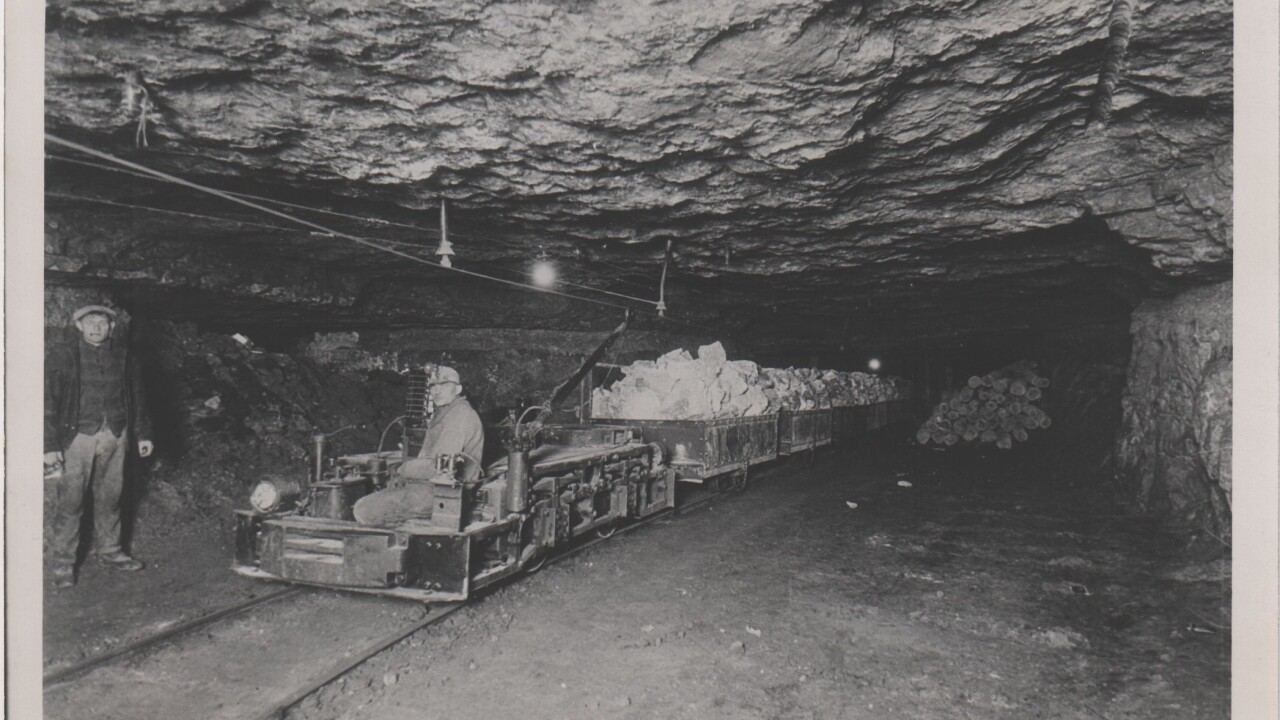GRAND RAPIDS, Mich. — Buried beneath 85 feet of Grand Rapids soil and bedrock lies a labyrinth — a maze of man-made and forgotten tunnels from the city's old gypsum-mining industry.
Sealed off at the surface, the mines are mostly abandoned. But at Michigan Natural Storage, a freight elevator burrows into the Alabastine Mine, connecting a modern warehousing operation to the city's deep, dark past.

"In many ways, we're a Michigan basement. What do you do with a basement? You put stuff down there," said Ron Kragt, the owner of the third-generation family business.
In 1946, Kragt's grandfather, Bert, bought the property from the then-bankrupt mining company for its above-ground warehouse space.
But a few years later, the city of Grand Rapids — wanting to divert traffic away from downtown — relocated its wholesale produce market next to Michigan Natural Storage.
Suddenly, what lay far below Bert Kragt's feet — six miles of deserted tunnels, shielded from the elements and naturally held at a constant 50-degree temperature — became the perfect starting point for an underground fridge.
"We consider ourselves pioneers in that respect of redeveloping and reusing a formally exploited resource," Kragt said.
The Kragts rebuilt the broken-down elevator shaft, cleared rubble from the tunnels and poured concrete, readying the space for apples, potatoes, carrots and more to arrive by rail.
Now in 2023, around 20% of the mine operates as a semi-refrigerated warehouse. The chilly hallways store documents, food and alcohol, resulting in a beer-like smell.

But pieces of the city's past still rust in the dark.
"Not only are you walking back in time but it's a completely different environment than anything you normally experience in day to day," said Dr. Cory Redman, science curator at the Grand Rapids Public Museum.
This May, Dr. Redman toured the Alabastine Mine as part of a geology conference.
"It's cool seeing that kind of exposed rock," Dr. Redman said. "I mean, you're 80 feet underground. How often does that happen?"
At a slightly higher depth — but still below ground — the museum stores gypsum samples at its Community Archives and Research Center.
The soft rose-colored mineral formed before Michigan's state fossil — the mastodon — walked the earth. More than 300 million years ago during the Mississippian Period, the land that would later hold Grand Rapids contained a shallow sea at the equator.
But over time, the sea retreated and its salt water evaporated, depositing a thick layer of gypsum into a sedimentary package of rock called the Michigan Formation.

For most of modern civilization, the gypsum lay largely hidden beneath a crust of shale and dolomite. But in 1827, a Native American trapper spotted an outcropping near Plaster Creek. Eleven years later, Michigan's first state geologist — Douglass Houghton — confirmed the mineral's presence.
The discovery set forth Grand Rapids' first industry.
"They would come in with picks and shovels and break the rock apart, load it by hand on mine carts, and pull the mine carts with horses," Kragt said.

In the 1880s, the Alabastine Mining Company dug an open quarry mine near present-day Marquette Park, later transitioning to shaft mining in 1907.
While the Grand Rapids Plaster Company and other area mines mixed their gypsum into plaster, drywall and fertilizer, the Alabastine operation produced whitewash.
"Think of Tom Sawyer painting the fences," Kragt said.
He estimates two to three dozen men descended into the tunnels at a time, individually mining eight to ten tons of rock per day. With wages set somewhere near 40 cents a ton, they made a living comparable to Detroit's auto plant workers — around $5 a day.
But the mining company failed to keep pace with technology and continued to collect gypsum by hand until declaring bankruptcy in 1943.
The industry transition to synthetic gypsum — a byproduct of coal-fired power plants — led to the demise of other local operations. In 1998, the Domtar Mine, formerly known as the Grand Rapids Plaster Company, closed.
Now, remnants remain: a corroded drill and a barely-there mine cart.
In the Alabastine Mine, an artesian well still produces water and is pumped daily by Michigan Natural Storage.
For years, the Kragts took schoolchildren into the tunnels, advertising the field trip as clean, cool and educational. But they stopped offering the public tours in the 2000s, due to an "unfortunate" regulatory climate.

"There's a rich history of gypsum in Grand Rapids." Kragt said. "It is really the first industry in West Michigan."
In its archives, the public museum preserves gypsum samples and sepia-toned photos of miners in overalls. While some artifacts remain a mystery, the GRPM has identified a 20th-century headlamp as one worn by three generations of a mining family who worked for the Grand Rapids Plaster Company.

"Now, Grand Rapids is kind of known as Beer City. Before that it was Furniture City," Dr. Redman said. "Before that it was, you know, gypsum."
That new nickname — Beer City — reaches 85 feet below, where Founders Brewing Company, a client of the Michigan Natural Storage, ages barrels of bourbon beside walls of gypsum.
The present, growing old with the past.






